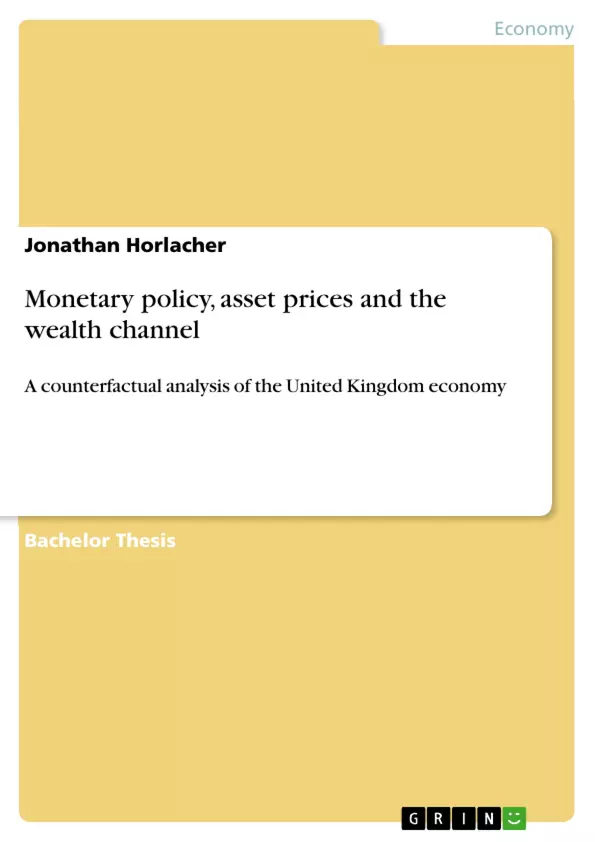This thesis examines whether monetary policy in the United Kingdom during the last 15 years should have reacted more strongly to asset price misalignments in financial assets and real estate assets, and if it should have reacted with different magnitude to the two asset classes. A counterfactual analysis using a dynamic structural general equilibrium (DSGE) model is conducted to test several scenarios, as well as to derive the optimal parameter set by exposing the model to shocks derived from historical data. It concludes that a more proactive monetary policy would have been preferable in the past, and that monetary policy should have reacted more to misalignments in real estate prices than in financial asset prices. Reacting to asset prices in general is found to be optimal in the random case.
Inhaltsverzeichnis (Table of Contents)
- 1 Introduction
- 2 Asset prices and their effects on the real economy
- 2.1 Asset prices and asset bubbles
- 2.2 Effects on the real economy
- 2.2.1 Wealth channel
- 2.2.2 Liquidity channel
- 2.3 Arguments pro and contra monetary action
- 3 Counterfactual analysis
- 3.1 Basic model
- 3.2 Asset prices model
- 3.3 Methodology
- 3.4 Dataset
- 3.5 Parameter estimates
- 3.6 Impulse response tests
- 4 Results
- 4.1 Loss function
- 4.2 Baseline results compared with reaction to asset prices
- 4.3 Optimal policy parameters
- 4.4 Robustness tests
- 4.4.1 Different baseline error terms
- 4.4.2 Random shocks
- 4.4.3 Different magnitude of the wealth channel
- 5 Conclusion
Zielsetzung und Themenschwerpunkte (Objectives and Key Themes)
This thesis explores the potential for monetary policy to more effectively address asset price misalignments in the United Kingdom. It aims to determine whether monetary policy should have responded more aggressively to price deviations in financial and real estate assets during the past 15 years and whether it should have adjusted its response based on the specific asset class. The study leverages a dynamic structural general equilibrium (DSGE) model to evaluate various scenarios and identify optimal policy parameters. Key themes include:- The impact of asset price misalignments on the real economy
- The role of monetary policy in managing asset price bubbles
- The relative effectiveness of monetary policy responses to different asset classes (financial vs. real estate)
- The application of DSGE modeling in analyzing counterfactual scenarios
- Optimal monetary policy parameters for addressing asset price misalignments
Zusammenfassung der Kapitel (Chapter Summaries)
- Chapter 1: Introduction This chapter introduces the topic of asset price misalignments and their impact on economic stability. It discusses the traditional approach of central banks, which often involved a reactive stance to asset bubbles, and argues for a more proactive monetary policy, particularly in light of the 2008 financial crisis. The chapter highlights the need to consider the impact of individual asset classes on aggregate demand, with a specific focus on financial assets and real estate.
- Chapter 2: Asset prices and their effects on the real economy This chapter explores the relationship between asset prices and the real economy. It defines asset price bubbles and outlines the mechanisms through which asset prices can affect economic activity, focusing on the wealth channel and the liquidity channel. The chapter also presents arguments for and against using monetary policy to address asset price misalignments.
- Chapter 3: Counterfactual analysis This chapter outlines the methodology and model used in the analysis. It details the dynamic structural general equilibrium (DSGE) model, which includes wealth channels for both financial and real estate assets. The chapter discusses the dataset, parameter estimates, and the application of impulse response tests.
- Chapter 4: Results This chapter presents the findings of the counterfactual analysis. It evaluates the performance of different monetary policy scenarios, including a baseline scenario and scenarios that involve varying degrees of response to asset price misalignments. The chapter analyzes the optimal policy parameters and conducts robustness tests to assess the sensitivity of the results to different assumptions.
Schlüsselwörter (Keywords)
This thesis investigates the role of monetary policy in addressing asset price misalignments, particularly in the context of the United Kingdom economy. Key topics explored include asset price bubbles, the wealth channel, the liquidity channel, dynamic structural general equilibrium (DSGE) modeling, counterfactual analysis, and optimal monetary policy parameters.- Quote paper
- Jonathan Horlacher (Author), 2010, Monetary policy, asset prices and the wealth channel, Munich, GRIN Verlag, https://www.grin.com/document/179138



